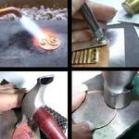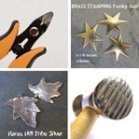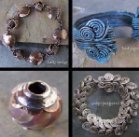Specific cleaning solution prior to applying patinas
If you don't use a tumbler what specific steps or products should you use to thoroughly clean your pieces before adding to the patina? I do not usually put a glossy finish on pieces. After all the construction is done I generally clean off the solder and do any additional filing and then am ready to patina. I have been cleaning by brass brushing with a soap solution but don't really feel like the pieces are clean enough. You have mentioned acetone but the smell is horrendous. Any milder chemicals you can suggest or methods to clean so the patina will cover more evenly? Also, what temperature are you suggesting the solution be for the best dipping? I use the patina gel and usually boil the water before adding, and heat the pieces in hot water as well, but I do not get a consistent result. Could the liquid be too hot? I just did a batch of about 30 pieces that just would not patina no matter what I tried. It either flaked off or built up like a sludge and looked horrible. This doesn't happen often but I would like to have better consistent results.
Stacy's Answer:
What metals are you working in Grace? Different metals benefit from different treatments.
How polished you take your jewelry largely depends on the look you are trying to create. For me, the patina is almost the last step in the fabrication process. But before I apply the patina, I make sure the piece is polished or finished the way I want....usually very shiny/well polished. This can be accomplished by either tumble polishing - which also cleans the metal - or by buffing the piece using a bench-top buffing machine, or with smaller buffs using a flexshaft. If you do not own a flexshaft, treat yourself! They are an invaluable tool to have in a jewelry studio. For small polishing jobs, you could use a dremel tool, but they have too much vibration for many of the applications a flexshaft can do. After buffing, thoroughly clean the piece using hot water, dish soap and a soft toothbrush to remove any buffing compound residue. Sometimes just a soft rag (old diapers work great if you can find them!) and some elbow grease works well to clean a piece after buffing.
I like to use a brass brush as a final cleaning before adding a patina on large copper or sometimes brass cuffs when I want a brushed or satin finish as the final finish. I scrub or buff again after applying a liver-of-sulfur to lighten up the patina and give the metal it's satin/brushed finish. For the brass, I sometimes leave the firescale and remove areas of it with a brass brush or buffer, leaving a very pretty dark chocolate antique finish on the metal with bits of brighter brass showing through. The brass brush will create a satin texture/finish and the buffing wheel, a high polish one.
Too hot of a LOS solution - like at the boiling point - does not work well on any metal. But a hot solution (one you can put your fingers in, but it's hot) is a must for copper. Heat the metal by dipping it in hot water so that you do not cool off the LOS solution by putting cold metal into it. If the LOS solution is too cool, the copper does not patina, but just gets slimed for lack of a better word, with a velvety, gooey layer of LOS gunk. It wipes off on your hands, the counter...and reveals metal underneath that is still brightish, blotchy copper. Yuck! For me, having the copper look black and almost lacquered when it comes out of the solution gives me a lovely, dark brown color after I've finished it. I like to let the pieces dry, then tumble polish for an hour or so. I then finish up by buffing with a Sunshine polishing cloth from Rio Grande to bring out the burnished copper highlights. A weaker solution produces lighter colors as does a faster dip time. You can experiment with this to find a look that works for you.
As some patinas are fragile and have to be waxed or lacquer coated to preserve them, I want to make sure the jewelry is polished and finished first. To preserve the patina, I coat it using Permalac lacquer. It's before the lacquer coating that I apply acetone to the metal to clean it. It won't harm the patina, but helps insure a better adhesion of the lacquer to the metal. I do not use acetone before adding a patina. But if your metal is oily or waxy, a patina won't stick either. A simple rinse with hot, soapy water like Dawn or a similar dish soap should clean the metal properly before adding your patina.
For silver, you can apply the LOS hot or at room temperature. You can get a range of rainbow colors by repeatedly dipping the silver in a cooler solution. But as great as those colors are, if you don't seal them, the metal will continue to oxidize and those cool colors will be lost. Granted, it takes a bit longer for silver to oxidize than say copper, but change it will! The cool LOS does not work well for me with copper. Scrubbing copper first with a brass brush then dipping in LOS can produce some lovely vivid orange, gold, green, magenta and blue tones, but they don't last if you don't get them sealed.
So to answer your question about what to use to clean the metal prior to the patina? Good ol' dish soap and hot water! No acetone! On a side note: LOS will not take on metal that has a heat patina. If you've used a torch on the copper, you must thoroughly clean/pickle the torch residue off. After rinsing, scrub with a brass brush or toothbrush with dish soap and water. Then apply your patina. Use the same mixture to clean excess LOS patina too and a soft toothbrush to access any nooks and crannies the patina build up might hide. (a brass brush at this point may remove too much of your patina)
A tumbler is not for everyone and can't be used for any and all jewelry polishing applications. But sometimes it is the right choice and can be a time saver to boot! While items are tumble polish/cleaning - YOU are free to create more lovely jewels! And you don't have to leave items in a tumbler until they're super shiny, but for a short time to primarily clean. Then add the finish you desire.
Join in and write your own page! It's easy to do. How? Simply click here to return to Jewelry Q & A.
















